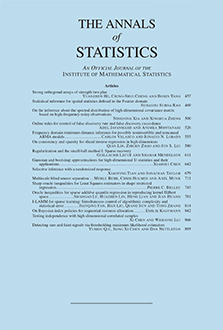Abstract
Bayesian variable selection has gained much empirical success recently in a variety of applications when the number K of explanatory variables $(x_1,\ldots,x_K)$ is possibly much larger than the sample size $n$. For generalized linear models, if most of the $x_j$’s have very small effects on the response $y$, we show that it is possible to use Bayesian variable selection to reduce overfitting caused by the curse of dimensionality $K\gg n$. In this approach a suitable prior can be used to choose a few out of the many $x_j$’s to model $y$, so that the posterior will propose probability densities $p$ that are “often close” to the true density $p^*$ in some sense. The closeness can be described by a Hellinger distance between $p$ and $p^*$ that scales at a power very close to $n^{-1/2}$, which is the “finite-dimensional rate” corresponding to a low-dimensional situation. These findings extend some recent work of Jiang [Technical Report 05-02 (2005) Dept. Statistics, Northwestern Univ.] on consistency of Bayesian variable selection for binary classification.
Citation
Wenxin Jiang. "Bayesian variable selection for high dimensional generalized linear models: Convergence rates of the fitted densities." Ann. Statist. 35 (4) 1487 - 1511, August 2007. https://doi.org/10.1214/009053607000000019
Information





